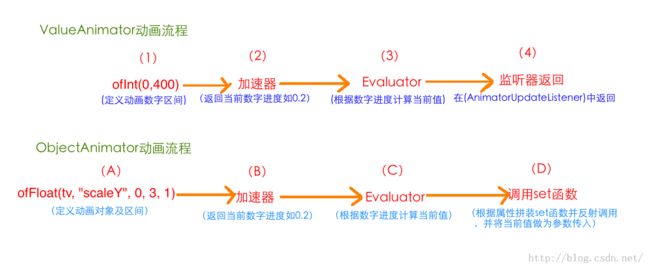android动画---ObjectAnimator基本使用
一、使用objectAnimator实现下图的效果(不会做gif图)
方法介绍:
public static ObjectAnimator ofFloat(Object target, String propertyName, float... values) 第一个参数用于指定这个动画要操作的是哪个控件
第二个参数用于指定这个动画要操作这个控件的哪个属性
第三个参数是可变长参数,这个就跟ValueAnimator中的可变长参数的意义一样了,就是指这个属性值是从哪变到哪。
activity_main.xml
<RelativeLayout xmlns:android="http://schemas.android.com/apk/res/android"
xmlns:tools="http://schemas.android.com/tools"
android:layout_width="match_parent"
android:layout_height="match_parent"
tools:context=".MainActivity"
android:gravity="bottom|center_horizontal">
<Button
android:id="@+id/menu"
style="@style/MenuStyle"
android:background="@mipmap/ic_launcher" />
<Button
android:id="@+id/item1"
style="@style/MenuItemStyle"
android:background="@mipmap/logo"
android:visibility="gone" />
<Button
android:id="@+id/item2"
style="@style/MenuItemStyle"
android:background="@mipmap/logo"
android:visibility="gone" />
<Button
android:id="@+id/item3"
style="@style/MenuItemStyle"
android:background="@mipmap/logo"
android:visibility="gone" />
<Button
android:id="@+id/item4"
style="@style/MenuItemStyle"
android:background="@mipmap/logo"
android:visibility="gone" />
<Button
android:id="@+id/item5"
style="@style/MenuItemStyle"
android:background="@mipmap/logo"
android:visibility="gone" />
</RelativeLayout>MainActivity.java
public class MainActivity extends ActionBarActivity implements View.OnClickListener {
private static final String TAG = "MainActivity";
private Button mMenuButton;
private Button mItemButton1;
private Button mItemButton2;
private Button mItemButton3;
private Button mItemButton4;
private Button mItemButton5;
private boolean mIsMenuOpen = false;
private int len = 200;
@Override
protected void onCreate(Bundle savedInstanceState) {
super.onCreate(savedInstanceState);
setContentView(R.layout.activity_main);
initView();
}
private void initView() {
mMenuButton = (Button) findViewById(R.id.menu);
mMenuButton.setOnClickListener(this);
mItemButton1 = (Button) findViewById(R.id.item1);
mItemButton1.setOnClickListener(this);
mItemButton2 = (Button) findViewById(R.id.item2);
mItemButton2.setOnClickListener(this);
mItemButton3 = (Button) findViewById(R.id.item3);
mItemButton3.setOnClickListener(this);
mItemButton4 = (Button) findViewById(R.id.item4);
mItemButton4.setOnClickListener(this);
mItemButton5 = (Button) findViewById(R.id.item5);
mItemButton5.setOnClickListener(this);
}
/** * 打开菜单的动画 * @param view 执行动画的view * @param index view在动画序列中的顺序 * @param total 动画序列的个数 * @param radius 动画半径 */
private void doAnimateOpen(View view, int index, int total, int radius) {
if (view.getVisibility() != View.VISIBLE) {
view.setVisibility(View.VISIBLE);
}
double degree = Math.PI * index / ((total - 1) ); // 计算每个button移动的角度
int translationX = (int) (radius * Math.cos(degree)); // 计算每个button在x轴移动的距离
int translationY = -(int) (radius * Math.sin(degree)); // 计算每个button在-y轴移动的距离
Log.d(TAG, String.format("degree=%f, translationX=%d, translationY=%d",
degree, translationX, translationY));
AnimatorSet set = new AnimatorSet();
//包含平移、缩放和透明度动画
set.playTogether(
// 移动
ObjectAnimator.ofFloat(view, "translationX", 0, translationX),
ObjectAnimator.ofFloat(view, "translationY", 0, translationY),
// 缩放
ObjectAnimator.ofFloat(view, "scaleX", 0f, 1f),
ObjectAnimator.ofFloat(view, "scaleY", 0f, 1f),
// 透明度
ObjectAnimator.ofFloat(view, "alpha", 0f, 1));
//动画周期为500ms
set.setDuration(1 * 500).start();
}
/** * 关闭菜单的动画 * @param view 执行动画的view * @param index view在动画序列中的顺序 * @param total 动画序列的个数 * @param radius 动画半径 */
private void doAnimateClose(final View view, int index, int total,
int radius) {
if (view.getVisibility() != View.VISIBLE) {
view.setVisibility(View.VISIBLE);
}
double degree = Math.PI * index / ((total - 1));// 计算每个button移动的角度
int translationX = (int) (radius * Math.cos(degree));// 计算每个button在x轴移动的距离
int translationY = -(int) (radius * Math.sin(degree));// 计算每个button在-y轴移动的距离
Log.d(TAG, String.format("degree=%f, translationX=%d, translationY=%d",
degree, translationX, translationY));
AnimatorSet set = new AnimatorSet();
//包含平移、缩放和透明度动画
set.playTogether(
// 移动
ObjectAnimator.ofFloat(view, "translationX", translationX, 0),
ObjectAnimator.ofFloat(view, "translationY", translationY, 0),
// 缩放
ObjectAnimator.ofFloat(view, "scaleX", 1f, 0f),
ObjectAnimator.ofFloat(view, "scaleY", 1f, 0f),
// 透明度
ObjectAnimator.ofFloat(view, "alpha", 1f, 0f));
//为动画加上事件监听,当动画结束的时候,我们把当前view隐藏
set.addListener(new Animator.AnimatorListener() {
@Override
public void onAnimationStart(Animator animator) {
}
@Override
public void onAnimationRepeat(Animator animator) {
}
@Override
public void onAnimationEnd(Animator animator) {
view.setVisibility(View.GONE);
}
@Override
public void onAnimationCancel(Animator animator) {
}
});
set.setDuration(1 * 500).start();
}
@Override
public void onClick(View v) {
if (v == mMenuButton) {
if (!mIsMenuOpen) {
mIsMenuOpen = true;
doAnimateOpen(mItemButton1, 0, 5, len);
doAnimateOpen(mItemButton2, 1, 5, len);
doAnimateOpen(mItemButton3, 2, 5, len);
doAnimateOpen(mItemButton4, 3, 5, len);
doAnimateOpen(mItemButton5, 4, 5, len);
} else {
mIsMenuOpen = false;
doAnimateClose(mItemButton1, 0, 5, len);
doAnimateClose(mItemButton2, 1, 5, len);
doAnimateClose(mItemButton3, 2, 5, len);
doAnimateClose(mItemButton4, 3, 5, len);
doAnimateClose(mItemButton5, 4, 5, len);
}
} else {
Toast.makeText(this, "你点击了" + v, Toast.LENGTH_SHORT).show();
}
}
}styles.xml
<style name="MenuStyle">
<item name="android:layout_width">50dp</item>
<item name="android:layout_height">50dp</item>
</style>
<style name="MenuItemStyle">
<item name="android:layout_width">45dp</item>
<item name="android:layout_height">45dp</item>
</style>
二、ObjectAnimator动画原理

在这张图中,将ValueAnimator的动画流程与ObjectAnimator的动画流程做了个对比。
可以看到ObjectAnimator的动画流程中,也是首先通过加速器产生当前进度的百分比,然后再经过Evaluator生成对应百分比所对应的数字值。这两步与ValueAnimator是完全一样的,唯一不同的是最后一步,在ValueAnimator中,我们要通过添加监听器来监听当前数字值。而在ObjectAnimator中,则是先根据属性值拼装成对应的set函数的名字,比如这里的scaleY的拼装方法就是将属性的第一个字母强制大写后,与set拼接,所以就是setScaleY。然后通过反射找到对应控件的setScaleY(float scaleY)函数,将当前数字值做为setScaleY(float scale)的参数将其传入。
这里在找到控件的set函数以后,是通过反射来调用这个函数的。
这就是ObjectAnimator的流程,最后一步总结起来就是调用对应属性的set方法,将动画当前数字值做为参数传进去。
根据上面的流程,这里有几个注意事项:
(1)、拼接set函数的方法:上面我们也说了是首先是强制将属性的第一个字母大写,然后与set拼接,就是对应的set函数的名字。注意,只是强制将属性的第一个字母大写,后面的部分是保持不变的。反过来,如果我们的函数名命名为setScalePointX(float ),那我们在写属性时可以写成“scalePointX”或者写成“ScalePointX”都是可以的,即第一个字母大小写可以随意,但后面的部分必须与set方法后的大小写保持一致。
(2)、如何确定函数的参数类型:上面我们知道了如何找到对应的函数名,那对应的参数方法的参数类型如何确定呢?我们在讲ValueAnimator的时候说过,动画过程中产生的数字值与构造时传入的值类型是一样的。由于ObjectAnimator与ValueAnimator在插值器和Evaluator这两步是完全一样的,而当前动画数值的产生是在Evaluator这一步产生的,所以ObjectAnimator的动画中产生的数值类型也是与构造时的类型一样的。那么问题来了,像我们的构造方法。
ObjectAnimator animator = ObjectAnimator.ofFloat(tv, "scaleY", 0, 3, 1); 由于构造时使用的是ofFloat函数,所以中间值的类型应该是Float类型的,所以在最后一步拼装出来的set函数应该是setScaleY(float xxx)的样式;这时,系统就会利用反射来找到setScaleY(float xxx)函数,并把当前的动画数值做为参数传进去。
那问题来了,如果没有类似setScaleY(float xxx)的函数,我们只实现了一个setScaleY(int xxx)的函数怎么办?这里虽然函数名一样,但参数类型是不一样的,那么系统就会报一个错误:

意思就是对应函数的指定参数类型没有找到。
(3)、调用set函数以后怎么办?从ObjectAnimator的流程可以看到,ObjectAnimator只负责把动画过程中的数值传到对应属性的set函数中就结束了,注意传给set函数以后就结束了!set函数就相当我们在ValueAnimator中添加的监听的作用,set函数中的对控件的操作还是需要我们自己来写的。
那我们来看看View中的setScaleY是怎么实现的吧:
/** * Sets the amount that the view is scaled in Y around the pivot point, as a proportion of * the view's unscaled width. A value of 1 means that no scaling is applied. * * @param scaleY The scaling factor. * @see #getPivotX() * @see #getPivotY() * * @attr ref android.R.styleable#View_scaleY */
public void setScaleY(float scaleY) {
ensureTransformationInfo();
final TransformationInfo info = mTransformationInfo;
if (info.mScaleY != scaleY) {
invalidateParentCaches();
// Double-invalidation is necessary to capture view's old and new areas
invalidate(false);
info.mScaleY = scaleY;
info.mMatrixDirty = true;
mPrivateFlags |= DRAWN; // force another invalidation with the new orientation
invalidate(false);
}
} 大家不必理解这一坨代码的意义,因为这些代码是需要读懂View的整体流程以后才能看得懂的,只需要跟着我的步骤来理解就行。这段代码总共分为两部分:第一步重新设置当前控件的参数,第二步调用Invalidate()强制重绘;
所以在重绘时,控件就会根据最新的控件参数来绘制了,所以我们就看到当前控件被缩放了。
(4)、set函数调用频率是多少:由于我们知道动画在进行时,每隔十几毫秒会刷新一次,所以我们的set函数也会每隔十几毫秒会被调用一次。
讲了这么多,就是为了强调一点:ObjectAnimator只负责把当前运动动画的数值传给set函数。至于set函数里面怎么来做,是我们自己的事了。
好了,在知道了ObjectAnimator的原理以后,下面就来看看如何自定义一个ObjectAnimator的属性吧。
三、自定义ObjectAnimator属性
上面我们已经看了使用View自带的set函数所对应属性的方法,而且理解了ObjectAnimator的动画实现原理,下面我们来自定义一个属性来看看实现效果吧。
我们在开始之前再来捋一下ObjectAnimator的动画设置流程:ObjectAnimator需要指定操作的控件对象,在开始动画时,到控件类中去寻找设置属性所对应的set函数,然后把动画中间值做为参数传给这个set函数并执行它。
所以,我们说了,控件类中必须所要设置属性所要对应的set函数。所以为了自由控制控件的实现,我们这里自定义一个控件。大家知道在这个自定义控件中,肯定存在一个set函数与我们自定义的属性相对应。
我们先来看看这段要实现的效果:
1、保存圆形信息类——Point
为了保存圆形的信息,我们先定义一个类:(Point.java)
public class Point {
private int mRadius;
public Point(int radius){
mRadius = radius;
}
public int getRadius() {
return mRadius;
}
public void setRadius(int radius) {
mRadius = radius;
}
} 这个类很好理解,只有一个成员变量mRadius,表示圆的半径。
2、自定义控件——MyPointView
然后我们自定义一个控件MyPointView,完整代码如下:
public class MyPointView extends View {
private Point mPoint = new Point(100);
public MyPointView(Context context, AttributeSet attrs) {
super(context, attrs);
}
@Override
protected void onDraw(Canvas canvas) {
if (mPoint != null){
Paint paint = new Paint();
paint.setAntiAlias(true);
paint.setColor(Color.RED);
paint.setStyle(Paint.Style.FILL);
canvas.drawCircle(300,300,mPoint.getRadius(),paint);
}
super.onDraw(canvas);
}
void setPointRadius(int radius){
mPoint.setRadius(radius);
invalidate();
}
} 在这段代码中,首先来看我们前面讲到的set函数:
void setPointRadius(int radius){
mPoint.setRadius(radius);
invalidate();
} 这个set函数所对应的属性应该是pointRadius或者PointRadius。前面我们已经讲了第一个字母大小写无所谓,后面的字母必须保持与set函数完全一致。
在setPointRadius中,先将当前动画传过来的值保存到mPoint中,做为当前圆形的半径。然后强制界面刷新在界面刷新后,就开始执行onDraw()函数。
3、使用MyPointView
首先,在MyActivity的布局中添加MyPointView的使用(main.xml):
<?xml version="1.0" encoding="utf-8"?>
<RelativeLayout xmlns:android="http://schemas.android.com/apk/res/android" android:orientation="vertical" android:layout_width="fill_parent" android:layout_height="fill_parent">
<Button android:id="@+id/btn" android:layout_width="wrap_content" android:layout_height="wrap_content" android:layout_alignParentLeft="true" android:padding="10dp" android:text="start anim" />
<Button android:id="@+id/btn_cancel" android:layout_width="wrap_content" android:layout_height="wrap_content" android:layout_alignParentRight="true" android:padding="10dp" android:text="cancel anim" />
<TextView android:id="@+id/tv" android:layout_width="100dp" android:layout_height="wrap_content" android:layout_centerHorizontal="true" android:gravity="center" android:padding="10dp" android:background="#ffff00" android:text="Hello qijian"/>
<com.example.BlogObjectAnimator1.MyPointView android:id="@+id/pointview" android:layout_width="match_parent" android:layout_height="match_parent" android:layout_below="@id/tv"/>
</RelativeLayout> 布局代码很好理解,根据效果图中的布局效果来理解,非常容易,就不再多讲
然后看看在MyActivity中,点击start anim后的处理方法:
public class MyActivity extends Activity {
private Button btnStart;
private MyPointView mPointView;
@Override
public void onCreate(Bundle savedInstanceState) {
super.onCreate(savedInstanceState);
setContentView(R.layout.main);
btnStart = (Button) findViewById(R.id.btn);
mPointView = (MyPointView)findViewById(R.id.pointview);
btnStart.setOnClickListener(new View.OnClickListener() {
@Override
public void onClick(View v) {
doPointViewAnimation();
}
});
}
…………
} 在点击start anim按钮后,开始执行doPointViewAnimation()函数,doPointViewAnimation()函数代码如下:
private void doPointViewAnimation(){
ObjectAnimator animator = ObjectAnimator.ofInt(mPointView, "pointRadius", 0, 300, 100);
animator.setDuration(2000);
animator.start();
} 在这段代码中,着重看ObjectAnimator的构造方法,首先要操作的控件对象是mPointView,然后对应的属性是pointRadius,然后值是从0到300再到100;
所以在动画开始以后,ObjectAnimator就会实时地把动画中产生的值做为参数传给MyPointView类中的setPointRadius(int radius)函数,然后调用setPointRadius(int radius)。由于我们在setPointRadius(int radius)中实时地设置圆形的半径值然后强制重绘当前界面,所以可以看到圆形的半径会随着动画的进行而改变。
四、注意——何时需要实现对应属性的get函数
我们再来看一下ObjectAinimator的下面三个构造方法:
public static ObjectAnimator ofFloat(Object target, String propertyName, float... values)
public static ObjectAnimator ofInt(Object target, String propertyName, int... values)
public static ObjectAnimator ofObject(Object target, String propertyName,TypeEvaluator evaluator, Object... values) 前面我们已经分别讲过三个函数的使用方法,在上面的三个构造方法中最后一个参数都是可变长参数。我们也讲了,他们的意义就是从哪个值变到哪个值的。
那么问题来了:前面我们都是定义多个值,即至少两个值之间的变化,那如果我们只定义一个值呢,如下面的方式:(同样以MyPointView为例)
ObjectAnimator animator = ObjectAnimator.ofInt(mPointView, "pointRadius",100); 从效果图中看起来是从0开始的,但是看log可以看出来已经在出警告了:

我们点了三次start anim按钮,所以这里也报了三次,意思就是没找到pointRadius属性所对应的getPointRadius()函数;
仅且仅当我们只给动画设置一个值时,程序才会调用属性对应的get函数来得到动画初始值。如果动画没有初始值,那么就会使用系统默认值。比如ofInt()中使用的参数类型是int类型的,而系统的Int值的默认值是0,所以动画就会从0运动到100;也就是系统虽然在找到不到属性对应的get函数时,会给出警告,但同时会用系统默认值做为动画初始值。
如果通过给自定义控件MyPointView设置了get函数,那么将会以get函数的返回值做为初始值:
public class MyPointView extends View {
private Point mPoint = new Point(100);
public MyPointView(Context context, AttributeSet attrs) {
super(context, attrs);
}
@Override
protected void onDraw(Canvas canvas) {
if (mPoint != null){
Paint paint = new Paint();
paint.setAntiAlias(true);
paint.setColor(Color.RED);
paint.setStyle(Paint.Style.FILL);
canvas.drawCircle(300,300,mPoint.getRadius(),paint);
}
super.onDraw(canvas);
}
public int getPointRadius(){
return 50;
}
public void setPointRadius(int radius){
mPoint.setRadius(radius);
invalidate();
}
} 我们在这里添加了getPointRadius函数,返回值是Int.有些同学可能会疑惑:我怎么知道这里要返回int值呢?
我们前面说过当且仅当我们在创建ObjectAnimator时,只给他传递了一个过渡值的时候,系统才会调用属性对应的get函数来得到动画的初始值!所以做为动画的初始值,那么在创建动画时过渡值传的什么类型,这里的get函数就要返回类型
public static ObjectAnimator ofObject(Object target, String propertyName,TypeEvaluator evaluator, Object... values) 比如上面的ofObject,get函数所返回的类型就是与最后一个参数Object… values,相同类型的。
在我们在MyPointView添加上PointRadius所对应的get函数以后重新执行动画:
ObjectAnimator animator = ObjectAnimator.ofInt(mPointView, "pointRadius",100);
animator.setDuration(2000);
animator.start();
从动画中可以看出,半径已经不是从0开始的了,而是从50开始的。
最后我们总结一下:当且仅当动画的只有一个过渡值时,系统才会调用对应属性的get函数来得到动画的初始值。
参考内容:
http://blog.csdn.net/harvic880925/article/details/50598322
http://blog.csdn.net/singwhatiwanna/article/details/17639987

